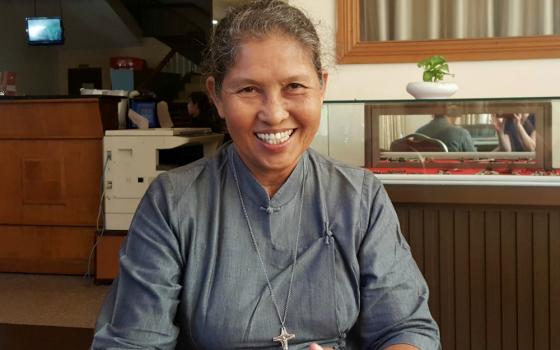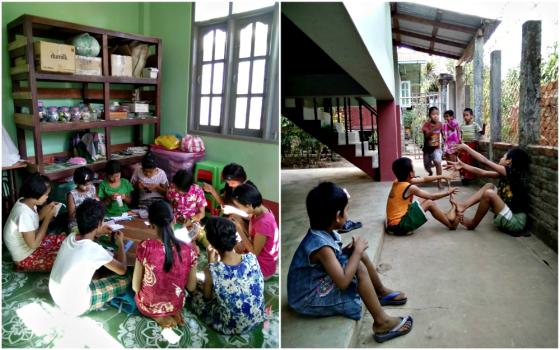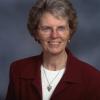In pioneering the care of HIV/AIDS patients in Myanmar more than 15 years ago, Sr. Martha Thwe of the Sisters of St. Joseph of the Apparition ranks among the most intrepid women religious I've met in my travels.
Not only did she undertake the ministry with little support from her congregation or the Catholic Church hierarchy in Myanmar, but she did so at a time when the official position of the authoritarian military government was that HIV/AIDS did not exist in the country.
Speaking with Global Sisters Report earlier this year from a hotel in Yangon, she recounted her often-harrowing experiences in Kyaikkhami, a small fishing town situated on the northwestern coast of Myanmar's Mon state. The ministry began as a simple gesture to bring soup to the dying and grew to partnerships with the United Nations and international HIV/AIDS organizations to bring life-saving treatments to people who have the disease.
Sister Martha admits that it is a bit odd that she was drawn to this ministry: "I am not a medical person; I am not a nurse; I knew nothing about this condition." But doing unexpected things was not new for her. Born and raised to uneducated farmers who were deeply religious, she was sent to a boarding house and girls high school in Mandalay run by the Apparition sisters, where she first felt called to religious life.
She laughingly shared how none of her schoolmates ever expected her to be a sister because as a young girl, she was "always fighting with boys." Now these friends applaud her work with HIV/AIDS.
As a young sister, she was sent to rural areas infested with cobras and malarial mosquitos. Amid her missions were stints of study and work in India, the Philippines and England, returning to Myanmar in 1997. She got started in Kyaikkhami while posted to care for children from nearby Karen state displaced in clashes with government forces.
In 2000, families were puzzled that members were dying of a strange disease. Men would travel from Myanmar to Indonesia, Malaysia and Thailand, where HIV/AIDS was in full bloom, then would return home to infect their wives and children.
Sister Martha said, "Our people were not aware — there was no awareness and no treatment for HIV. The symptoms looked very much like TB [tuberculosis] but we didn't know the cause or source [of the infection or] how to prevent it. The worst thing was the government had already pledged to the world that there was no HIV in Myanmar."
At first, she noticed only a few cases, but then saw the disease was spreading. Those infected became isolated, forced to live in huts and shunned from communities, families, clinics and hospitals. "As a non-medical person, the only thing I wanted was to provide one meal a day for these people in my convent." She bought chicken bones and rice and made soup. However, "in those days the [military] government did not allow me to group people [without permission]. Once I got permission, I could feed five at a time. We didn't know anything about how the infection was transmitted, so [even] the sisters said, 'Don't bring them to the convent.' I had to meet them under a tree."
"I went from house to house and found so many people with HIV and malaria. They had nothing to eat. I brought them soup and very simple medicine to bring down fever, the only medicine that I could give."
Christine, a high school student who had finished her exams and lived at the sisters' hostel and Therese, a Catholic woman, mother and former boarder, volunteered to help. "My soup bucket was getting bigger and bigger and at the end I had to make two buckets," Sister Martha recalled.
Some people she was serving were frightened of her religious habit. She sought and eventually got permission from her superiors in Rome to design her own dress that made her more accessible to the people.
While she laughs easily now about the twists and turns her life took in starting this ministry, her face grew sad and troubled at those early memories. "Those were the worst days," she said. "AIDS was in full bloom in the villages — people were burying the dead and they didn't know what it was."
She eventually learned the name of the disease but was warned repeatedly by local government authorities that the official position was that it didn't exist in the country and she was not to even mention that it was HIV/AIDS.
She wanted to care for the people legally, so she began looking for ways. She met a doctor with the United Nations Development Program in charge of that region and shared with him her work of feeding the sick and dying. "I had no money and no sisters to help," she said. The U.N. doctor gave her $300 to continue her feeding project, which included about 20 adult HIV/AIDS patients and their 20 children.
"I told him, 'I don't know anything about HIV, what is it? Teach me. Tell me about HIV.' I was told it had to do with sex. I had never heard of sex talked about so openly." Fortunately, the government extended the U.N. Development Program contract, which also evolved to include a formal relationship with her group in 2002.
She eventually confided in Daw Wisari, an elderly Buddhist nun and friend, about her soup ministry. Wisari volunteered to help. Now Martha had three women helping her.
As the ministry grew, the women attracted suspicion from some local townspeople. A summer program to help children of AIDS patients catch up on school studies was rumored to be a religious education program. Speculation was that she was trying to convert the Buddhist nun and the patients.
"Such a mischief," she said. Her helpers grew worried but she was resolute. "I said what we are doing is a good thing — we were helping people — why are they bothering us?" The Apparition sisters had been in that community for many years and had never before been accused of trying to convert anyone.
However, she was soon summoned to the local township government office. Because she knew the local official, he defended her, but explained she had erred by not getting local authority first. At an advocacy meeting a few months later, about 50 police officers, teachers and doctors showed up to vouch for her and her work. Most were Buddhist.
"We said our organization is purely humanitarian — not about religion. We are not trying to convert anyone." She noted, too, that her supporters reported that only love, forgiveness, sharing and caring were part of the service given. "It was an interreligious dialogue at the local level — not for the sake of meeting or giving talks but doing something together locally."
The authorities then left her alone, also knowing the U.N. was in the background. "So from that time, we were in peace, working for another five years. During this time, we learned we needed data collection, financial tracking and record-keeping." The International HIV/AIDS Alliance from Europe gave her funding and helped her design a structure for her organization. She named it Myitta Kyaemone, or Mirror of Charity, which also describes the spirit of her congregation.
Other donors, including embassies from Germany, Australia and elsewhere, came forth with financing for buildings and other needs. The government of Japan, under its Grassroots Grant Assistance Scheme, gave her $71,582 in 2008 to upgrade the original center she had built bit by bit. They also contributed to the purchase of sewing machines for vocational training.
Despite those successes, the ministry was difficult. The number she and the small group ministered to stayed around 20 to 30 people. "People kept dying," she said. "Children were dying. We would have both Buddhist and Christian funerals. It was very depressing. After the funerals, people among us would wonder who would be the next."
For her, feeding the patients wasn't enough. She began hearing about new things being tried in other countries. She wanted her local doctors to know more, too. So, in 2007, "we secretly sent a doctor to Thailand to learn more about [the disease] and treatment."
She herself attended a meeting in Colombo, Sri Lanka, where she heard about antiretroviral medications. One of the doctor lecturers she met there was planning to visit Yangon. She was determined to get some of her patients to him. This led to her most dangerous expedition, in 2007 — just as the government was cracking down on protests by civilians and Buddhist monks, later known as the "Saffron Revolution."
She got a bus to transport 35 patients to Yangon — 11 were children, the youngest just 3 months old. "The patients and children were really in a very bad state. ... Some could have died." She cooked curry and rice and they set off, despite the dangers. She said, "The worst thing was the checkpoints, which were very tense because the country was in turmoil." Luckily, the soldiers waved them through once she said they had HIV patients aboard.
With no place to stay, she phoned her friends and networks. A Buddhist monk invited the group to stay in his monastery. The doctors completed testing and counseling in a week, giving her medicine to treat 22 of the patients whose conditions qualified for treatment. "I really wanted to jump for joy. I was so happy," she recalled.
She took the group back to Mon state as the government crackdown continued: "Monks were being beaten and jailed, and the whole time, I was out buying things for the children. I risked my life, because I was giving the medicine to 22 patients," even while it was thought there was no antiretroviral medicine in the country. It was an illegal action. The doctor also broke rules of his international organization by giving Sister Martha the drugs, being she was neither nurse nor doctor. "He did this to save lives," she said.
Twenty then-dying patients, 4 and 5 years old, are now in high school. In the end, another international AIDS organization gave her additional antiretroviral treatments. "I was saving lives, and if for that you [the government] want to put me in jail — then put me in jail."
What about the future? "Now, in 2017, decentralization has come and so [we do not know]. People can now go to the hospital for the medicine. We can still do patient counseling, provide nutrition and other medicines not available at the hospitals."
Her companion, the Buddhist nun, died a few years ago, but she still has support from the first two women. "The Alliance for HIV/AIDS is still with us," along with her 10-year friend from Colombo who started his own nongovernmental organization, Medical Action Myanmar.
In 2006, Sister Martha went to Kawthaung, a small border town across from Ranong, Thailand, to expand her ministry. She purchased a small piece of land for a building and the project is growing. "We are assisting the government hospital where over 300 HIV patients, mostly migrants, are registered. We provide shelter for the homeless and abandoned and with generous friends near and far, we are constructing a new building to increase [shelter] rooms."
"We fly any children that need special care to Kyaikkhami, our main center. We give formal education to abandoned children, and we send non-HIV children too old for regular school to a UNICEF Non Formal Center in Kyaikkhami."
Sister Martha described the new place at Kawthaung as a beautiful border town and commercial center, but "the poor, especially girls, are at risk of human trafficking, drug trading and commercial sex." The sisters do all they can to protect them. "One of my objectives is to open classes for overaged migrant children."
When I asked about her biggest disappointment, she said, "I need religious people to come and work. There are girls but they have to go back to their families." Currently, she has one sister helping in Mon state and another one in Kawthaung. "Sisters come for a time, but do not stay long. ... I need dedicated sisters."
Sister Martha's experience of being marginalized in this ministry, particularly in the beginning, is a common story of many sisters I have met along the way who take risks to meet unusual needs. The rest of us need such gutsy visionaries to help us see beyond what we know and inspire us with courage to join them.
[Joyce Meyer is a member of the Sisters of the Presentation of the Blessed Virgin Mary and is GSR's liaison to women religious outside of the United States.]





